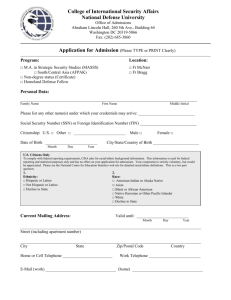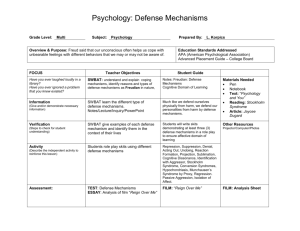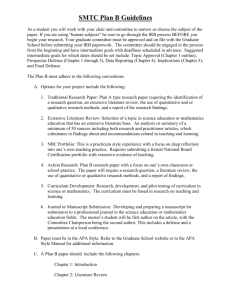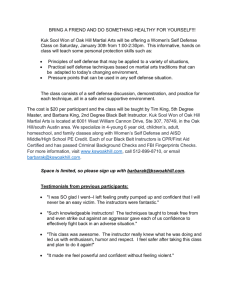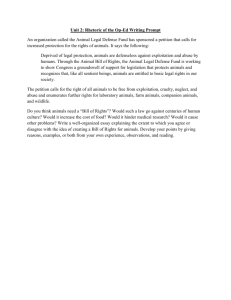Preface and Acknowledgements
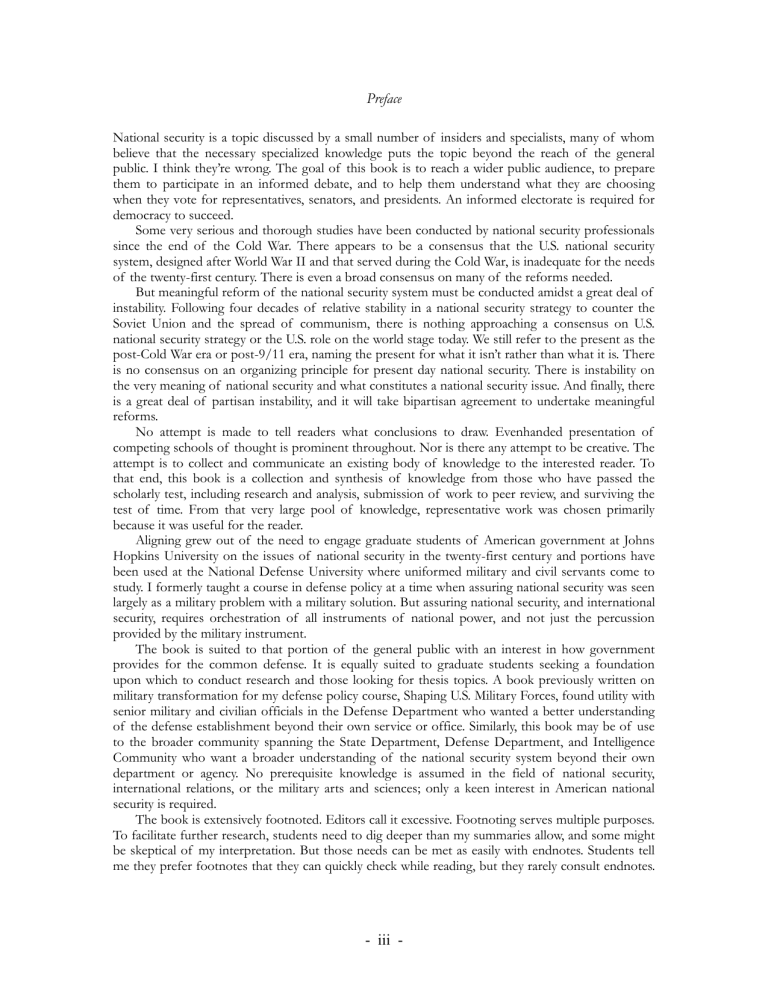
Preface
National security is a topic discussed by a small number of insiders and specialists, many of whom believe that the necessary specialized knowledge puts the topic beyond the reach of the general public. I think they’re wrong. The goal of this book is to reach a wider public audience, to prepare them to participate in an informed debate, and to help them understand what they are choosing when they vote for representatives, senators, and presidents. An informed electorate is required for democracy to succeed.
Some very serious and thorough studies have been conducted by national security professionals since the end of the Cold War. There appears to be a consensus that the U.S. national security system, designed after World War II and that served during the Cold War, is inadequate for the needs of the twenty-first century. There is even a broad consensus on many of the reforms needed.
But meaningful reform of the national security system must be conducted amidst a great deal of instability. Following four decades of relative stability in a national security strategy to counter the
Soviet Union and the spread of communism, there is nothing approaching a consensus on U.S. national security strategy or the U.S. role on the world stage today. We still refer to the present as the post-Cold War era or post-9/11 era, naming the present for what it isn’t rather than what it is. There is no consensus on an organizing principle for present day national security. There is instability on the very meaning of national security and what constitutes a national security issue. And finally, there is a great deal of partisan instability, and it will take bipartisan agreement to undertake meaningful reforms.
No attempt is made to tell readers what conclusions to draw. Evenhanded presentation of competing schools of thought is prominent throughout. Nor is there any attempt to be creative. The attempt is to collect and communicate an existing body of knowledge to the interested reader. To that end, this book is a collection and synthesis of knowledge from those who have passed the scholarly test, including research and analysis, submission of work to peer review, and surviving the test of time. From that very large pool of knowledge, representative work was chosen primarily because it was useful for the reader.
Aligning grew out of the need to engage graduate students of American government at Johns
Hopkins University on the issues of national security in the twenty-first century and portions have been used at the National Defense University where uniformed military and civil servants come to study. I formerly taught a course in defense policy at a time when assuring national security was seen largely as a military problem with a military solution. But assuring national security, and international security, requires orchestration of all instruments of national power, and not just the percussion provided by the military instrument.
The book is suited to that portion of the general public with an interest in how government provides for the common defense. It is equally suited to graduate students seeking a foundation upon which to conduct research and those looking for thesis topics. A book previously written on military transformation for my defense policy course, Shaping U.S. Military Forces, found utility with senior military and civilian officials in the Defense Department who wanted a better understanding of the defense establishment beyond their own service or office. Similarly, this book may be of use to the broader community spanning the State Department, Defense Department, and Intelligence
Community who want a broader understanding of the national security system beyond their own department or agency. No prerequisite knowledge is assumed in the field of national security, international relations, or the military arts and sciences; only a keen interest in American national security is required.
The book is extensively footnoted. Editors call it excessive. Footnoting serves multiple purposes.
To facilitate further research, students need to dig deeper than my summaries allow, and some might be skeptical of my interpretation. But those needs can be met as easily with endnotes. Students tell me they prefer footnotes that they can quickly check while reading, but they rarely consult endnotes.
- iii -
Accordingly, I chose to favor my students over professional editorial advice. The excessive footnoting remains.
Experts will certainly find errors both of omission and commission for which I am alone responsible. Reports of errors, small or large, will be received appreciatively at drworley@jhu.edu.
- iv -
Acknowledgments
The Project on National Security Reform provided a valuable opportunity to study the U.S. national security system. The many meetings brought together working practitioners who experienced firsthand the difficulties of implementing U.S. policies in Iraq, Afghanistan, the Horn of Africa, and in Washington. My thanks to Jim Locher, president and CEO of the Project, and to all those who came together to solve problems.
The Johns Hopkins University Center for Advanced Governmental Studies has contributed richly to this work. Special thanks are owed to my students who have been exposed to various versions of the text. Many are young congressional staffers working long hours for modest pay.
Many come from the executive branch departments of State, Defense, and Justice. Some come from across the Intelligence Community. A few are journalists. All somehow find the time and energy for graduate study to improve their ability to serve the nation. All have taught me something about the workings, good and bad, of our government.
In the midst of hyperpartisanship, the Congressional Research Service somehow continues to do quality research and analysis. My respect to Louis Fisher and his associates for their work on presidential war power, and to Richard Best for his work on the National Security Council.
Special appreciation is owed to the IBM Center for the Business of Government for its generous grant that produced the chapters on the National Security Council.
I also want to acknowledge a handful of currently serving national security professionals who offered encouragement late in the process when a morale boost was needed after two university presses fumbled with the manuscript for eighteen months. From the Mission Command Battle Lab at Fort Leavenworth, Kansas, are Richard Pedersen and Thomas Bryant; from the Joint Special
Operations University at Tampa, Florida, William Knarr; and from the National Defense University in Washington, D.C., Michael Mazarr, professor at the National War College, and Frank Hoffman, director of NDU Press.
- v -




